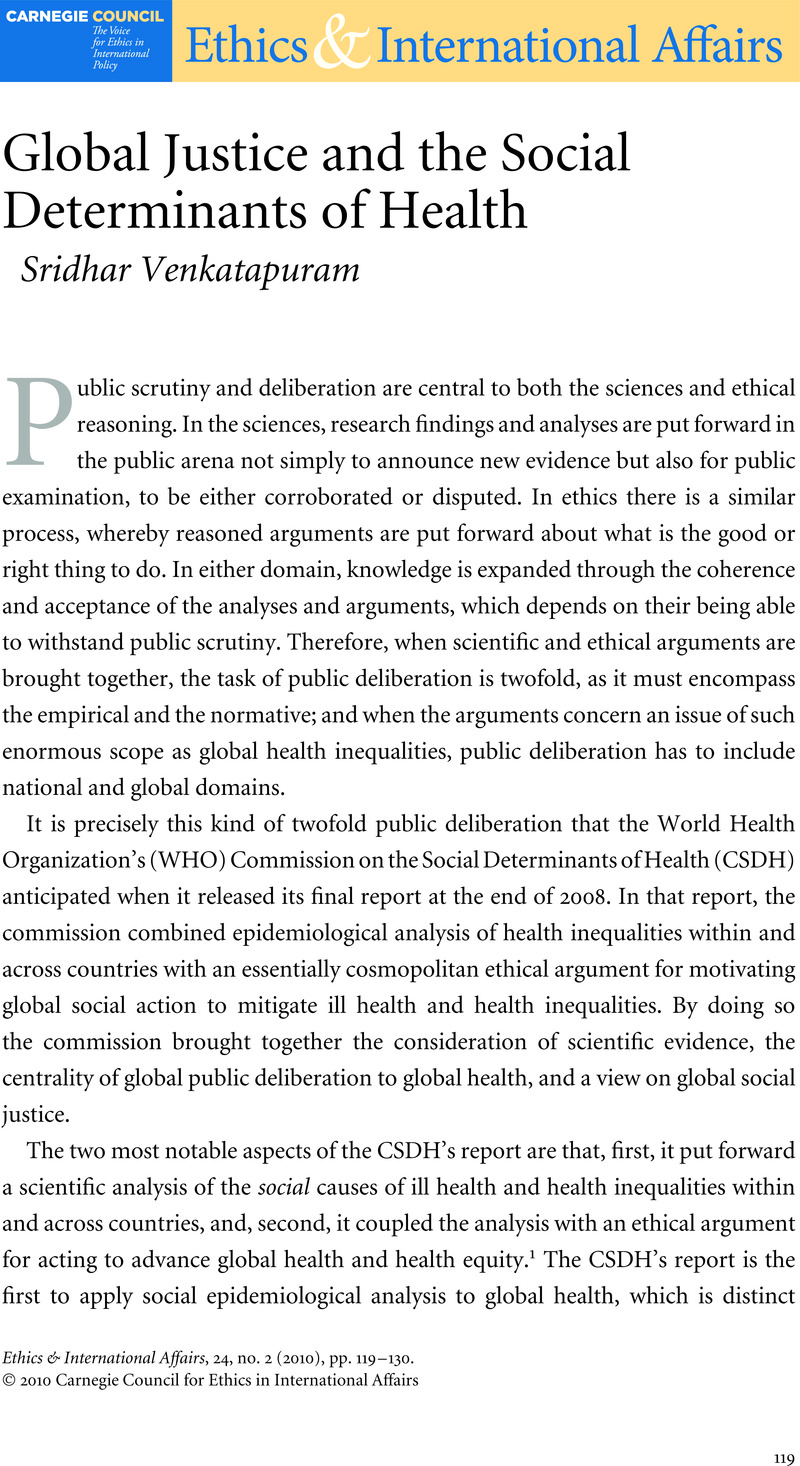Article contents
Global Justice and the Social Determinants of Health
Published online by Cambridge University Press: 25 March 2011
Abstract

- Type
- Essays
- Information
- Copyright
- Copyright © Carnegie Council for Ethics in International Affairs 2010
References
NOTES
1 The report and information about the commission are available at http:\\www.who.int/social_determinants/en/.
2 Paula Braveman et al., “World Health Report 2000: How It Removes Equity from the Agenda for Public Health Monitoring and Policy,” British Medical Journal 323 (2001); and C. J. Murray, E. E. Gakidou, and J. Frenk, “Health Inequalities and Social Group Differences: What Should We Measure?” Bull World Health Organ 77, no. 7 (1999).
3 “The Price of Being Well,” Economist, August 30, 2008; Tony Blakely, “Iconography and Commission on the Social Determinants of Health (and Health Inequity),” Journal of Epidemiology & Community Health 62, no. 12 (2008); and M. Marmot and S. Friel, “Global Health Equity: Evidence for Action on the Social Determinants of Health,” Journal of Epidemiology & Community Health 62, no. 12 (2008).
4 Information about the commission and report is available at the U.K. Department of Health website at http:\\www.dh.gov.uk/en/Publichealth/Healthinequalities/DH_094770.
5 N. Krieger, “Epidemiology and Social Sciences: Towards a Critical Reengagement in the 21st Century,” Epidemiologic Review 22, no. 1 (2000), pp. 155–63. Also see Kenneth J. Rothman, Sander Greenland, and Timothy L. Lash, Modern Epidemiology, 3rd ed. (Philadelphia: Wolters Kluwer Health/Lippincott Williams & Wilkins, 2008).
6 N. Krieger, “Epidemiology and the Web of Causation: Has Anyone Seen the Spider?” Social Science & Medicine 39, no. 7 (1994); N. Krieger, “Theories for Social Epidemiology in the 21st Century: An Ecosocial Perspective,” International Journal of Epidemiology 30, no. 4 (2001); M. Susser and E. Susser, “Choosing a Future for Epidemiology: I. Eras and Paradigms,” American Journal of Public Health 86, no. 5 (1996); and M. Susser and E. Susser, “Choosing a Future for Epidemiology: II. From Black Box to Chinese Boxes and Eco-Epidemiology,” American Journal of Public Health 86, no. 5 (1996).
7 Social epidemiology as a distinct discipline is new, as evidenced by the publication of one of its first textbooks in 2000, Lisa F. Berkman and Ichiro Kawachi, Social Epidemiology (New York: Oxford University Press, 2000).
8 Susser and Susser, “Choosing a Future for Epidemiology: I. Eras and Paradigms”; and Susser and Susser, “Choosing a Future for Epidemiology: II.”
9 Though a declining gradient in health achievements parallel to socioeconomic gradient across British society had long been observed, the identification of such a gradient within the subpopulation of British civil servants was very surprising and significant. Even after accounting for such behaviors as smoking, diet, and exercise, the gradient in health achievements is still clearly visible. The Whitehall study population, in effect, represented a microcosm of the broader society while allowing researchers to control for the various categories of individual-level factors, which include biology, behaviors, and material exposures and deprivations. See M. G. Marmot et al., “Health Inequalities among British Civil Servants: The Whitehall II Study,” Lancet 337, no. 8754 (1991); and M. G. Marmot et al., “Employment Grade and Coronary Heart Disease in British Civil Servants,” Journal of Epidemiology & Community Health 32, no. 4 (1978).
10 E. Brunner, “Biology and Health Inequality,” PLoS Biology 5, no. 11 (2007); J. Macleod and G. Davey Smith, “Psychosocial Factors and Public Health: A Suitable Case for Treatment?” Journal of Epidemiology & Community Health 57, no. 8 (2003); and A. Singh-Manoux, “Psychosocial Factors and Public Health,” Journal of Epidemiology & Community Health 57, no. 8 (2003).
11 P. Braveman and E. Tarimo, “Social Inequalities in Health within Countries: Not Only an Issue for Affluent Nations,” Social Science & Medicine 54, no. 11 (2002).
12 For a good overview of the field of social epidemiology, see Berkman and Kawachi, Social Epidemiology; and Richard Wilkinson and M. G. Marmot, Social Determinants of Health: The Solid Facts (Copenhagen: Centre for Urban Health, World Health Organization, Regional Office for Europe, 1998). Also see the journals Social Science & Medicine and Journal of Epidemiology & Community Health.
13 Krieger, “Epidemiology and the Web of Causation”; David Halpern et al., “Personal Responsibility and Changing Behaviour: The State of Knowledge and Its Implications for Public Policy,” Cabinet Office, Prime Minister's Strategy Unit (2004); and D. I. Wikler, “Persuasion and Coercion for Health: Ethical Issues in Government Efforts to Change Life-Styles,” Milbank Memorial Fund Quarterly 56, no. 3 (1978).
14 Peter Singer, “Outsiders: Our Obligations to Those Beyond Our Borders,” in Deen K. Chatterjee, ed., The Ethics of Assistance: Morality and the Distant Needy, Cambridge Studies in Philosophy and Public Policy (Cambridge: Cambridge University Press, 2004).
15 Amartya Sen, The Idea of Justice (London: Allen Lane, 2009).
16 Ibid., pp. 205–07.
17 Ibid., p. 260.
- 19
- Cited by




